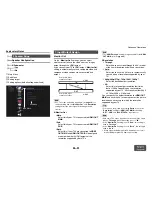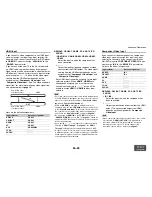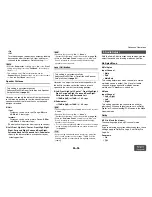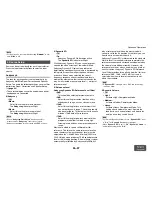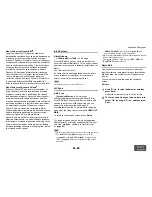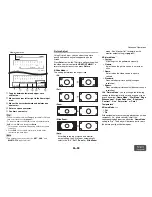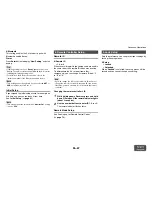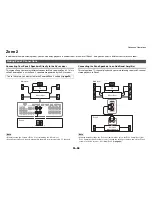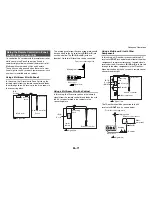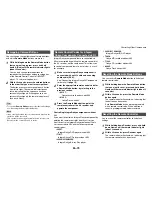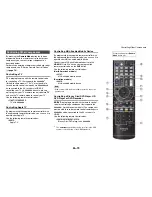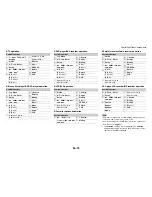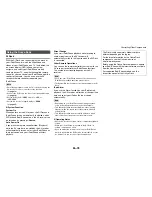
Advanced Operations
En-61
Operating
procedure
(
➔
page 50
)
Setting the Incoming Digital Signal (Fixed
Mode)
■
Fixed Mode
`
Off
:
The format is detected automatically. If no digital
input signal is present, the corresponding analog
input is used instead.
`
PCM
:
Only 2-channel PCM format input signals will be
heard. If the input signal is not PCM, the
PCM
indicator will flash and noise may also be
produced.
`
DTS
:
Only DTS (but not DTS-HD) format input signals
will be heard. If the input signal is not DTS, the
dts
indicator will flash and there will be no
sound.
When “
HDMI
”, “
COAXIAL
” or “
OPTICAL
” is selected
in the “
Audio Selector
” setting, you can then specify
the signal type in “
Fixed Mode
”.
Normally, the AV receiver detects the signal format
automatically. However, if you experience either of
the following issues when playing PCM or DTS
material, you can manually set the signal format to
PCM or DTS.
• If the beginnings of tracks from a PCM source are
cut off, try setting the format to PCM.
• If noise is produced when fast forwarding or
reversing a DTS CD, try setting the format to DTS.
Note
• The setting will be reset to “
Off
” when you change the
setting in “
Audio Selector
”.
You can assign a default listening mode to each input
source that will be selected automatically when you
select each input source. For example, you can set
the default listening mode to be used with Dolby
Digital input signals. You can select other listening
modes during playback, but the mode specified here
will be resumed once the AV receiver has been set to
standby.
■
Analog/PCM/Digital
With this setting, you can specify the listening mode
used when an analog (CD, TV, LD, VHS, MD,
turntable, radio, cassette, cable, satellite, etc.) or
PCM digital (CD, DVD, etc.) audio signal is played.
■
Mono/Multiplex Source
With this setting, you can specify the listening mode
used when a mono digital audio signal is played
(DVD, etc.).
■
2ch Source
With this setting, you can specify the listening mode
used when 2-channel (2/0) stereo digital sources,
such as Dolby Digital or DTS, are played.
■
Dolby D/Dolby D Plus/TrueHD
With this setting, you can specify the listening mode
used when Dolby Digital or Dolby Digital Plus
format digital audio signals are played (DVD, etc.).
Specifies the default listening mode for Dolby
TrueHD sources, such as Blu-ray or HD DVD (input
via HDMI).
■
DTS/DTS-ES/DTS-HD
With this setting, you can specify the listening mode
used when DTS or DTS-HD High Resolution format
digital audio signals are played (DVD, LD, CD,
etc.). Specifies the default listening mode for DTS-
HD Master Audio sources, such as Blu-ray or HD
DVD (input via HDMI).
■
Other Multich Source
Specifies the default listening mode for
multichannel PCM sources from
HDMI IN
such as
DVD-Audio, and DSD multichannel sources such
as Super Audio CD.
5. Listening Mode Preset
1
Use
q
/
w
to select the input source that you
want to set, and then press Enter.
The following menu appears.
2
Use
q
/
w
to select the signal format that you
want to set, and then use
e
/
r
to select a
listening mode.
Only listening modes that can be used with each
input signal format can be selected (
➔
pages 40
to
44
).
The “
Last Valid
” option means that the listening
mode selected last will be used.
The “
Straight Decode
” option means that
straight decoding listening mode (Dolby Digital,
DTS, etc.) is selected.
Note
• For the “
TUNER
” input selector, only “
Analog
” will be
available.
• For the “
NET
” or
“USB
”
input selector, “
Digital
” and
“
TrueHD
” will be available.
Default listening mode for analog and PCM sources.
Analog/PCM
Mono/Multiplex Source
2ch Source
Dolby D/Dolby D Plus/TrueHD
DTS/DTS-ES/DTS-HD
Other Multich Source
All Ch Stereo
e
r
5-1. Listening Mode Preset
BD/DVD
Full Mono
PLIIx Movie
Straight Decode
Straight Decode
Straight Decode
• For the “
BLUETOOTH
” input selector, only “
Digital
”
is available.
Summary of Contents for DTR-30.5
Page 1: ...AV Receiver DTR 30 5 Instruction Manual...
Page 95: ...Appendix En 95 Memo...





